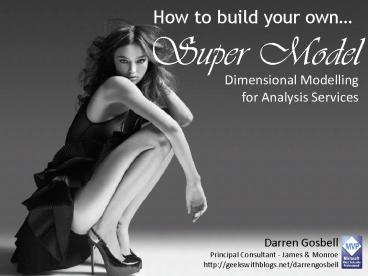Dimensional Modelling 101 - PowerPoint PPT Presentation
1 / 39
Title:
Dimensional Modelling 101
Description:
Further Reading The Data Warehouse Toolkit by Ralph Kimball & Margy Ross The Data Warehouse Lifecycle Toolkit by Ralph Kimball & Margy Ross Why Build a ... – PowerPoint PPT presentation
Number of Views:68
Avg rating:3.0/5.0
Title: Dimensional Modelling 101
1
How to build your ownSuper Model
Dimensional Modelling for Analysis Services
Darren GosbellPrincipal Consultant - James
Monroehttp//geekswithblogs.net/darrengosbell
2
Agenda
- Why build a Dimensional Model?
- What is a Dimensional Model?
- Overview of some modelling techniques.
- What functionality does Analysis Services provide
to help us?
3
Further Reading
- The Data Warehouse Toolkit by Ralph Kimball
Margy Ross - The Data Warehouse Lifecycle Toolkit by Ralph
Kimball Margy Ross
4
Why Build a Dimensional Model
OLTP System Dimensional Model
Process Oriented Subject Oriented
Transactional Aggregate
Current Historic
5
What is a Dimensional Model?
- A De-normalized database.
- Designed for ease of querying, not for
transactional updates. - Built to support aggregate queries
- Modelled around business subject areas.
6
Facts Dimensions
- There are two main types of objects in a
dimensional model - Facts are quantitative measures that we wish to
analyse and report on. - Dimensions contain textual descriptors of the
business. They provide context for the facts.
7
A Transactional Database
Countries
CountryID
Description
Addresses
AddressID
StateID
Street
States
StateID
CountryID
Desc
Customers
CustomerID
AddressID
Name
OrderHeader
OrderHeaderID
CustomerID
OrderDate
FreightAmount
Products
ProductID
Description
Size
OrderDetails
OrderHeaderID
ProductID
Amount
8
A Dimensional Model
Customers
CustomerID
Name
Street
State
Country
Time
TimeID
Date
Month
Quarter
Year
FactSales
CustomerID
ProductID
TimeID
SalesAmount
Products
ProductID
Description
Size
Subcategory
Category
9
Star Schema
10
Snowflake Schema
11
Building a Model - Facts
- You have to talk to the business.
- Identify Facts by looking for quantitative values
that are reported. - Make sure the granularity is right.
12
Building a Model - Dimensions
- Identify Dimensions by listening for by words.
- Look for related attributes that should be part
of a single dimension. - Pay attention to how Dimensions change over
time and in relation to each other.
13
Slowly Changing Dimensions -Handling Changes
over time
14
If you dont consider changes over time
yourmodel will start out like this
15
but ending up like this!
16
Type 1 Slowly Changing Dimension
- The simplest form
- Only updates existing records
- Overwrites history
17
Type 1 Slowly Changing Dimension
CustomerID Code Name State Gender
1 K001 Miranda Kerr NSW F
CustomerID Code Name State Gender
1 K001 Miranda Kerr VIC F
18
Type 2 Slowly Changing Dimension
- Allows the recording of changes of state over
time - Generates a new record each time the state
changes - Usually requires the use of effective dates when
joining to facts.
19
Type 2 Slowly Changing Dimension
CustomerID Code Name State Gender Start End
1 K001 Miranda Kerr NSW F 1/1/09 ltNULLgt
CustomerID Code Name State Gender Start End
1 K001 Miranda Kerr NSW F 1/1/09 23/2/09
2 K001 Miranda Kerr VIC F 24/2/09 ltNULLgt
23/2/09
20
Type 3 Slowly Changing Dimension
- De-normalized change tracking
- Only keeps a limited history
- Stores changes in separate columns
21
Type 3 Slowly Changing Dimension
CustomerID Code Name Current State Gender Prev State
1 K001 Miranda Kerr F ltNULLgt
NSW
VIC
22
Relationships between facts
and dimensions
23
Regular Relationships
- Most Common relationship
- Works like an inner join between the fact and
dimension
24
DEMO
- Regular Relationships
25
Many to Many Relationships
- Allows for the situation where you want to
associate more than one member from a dimension
with a single fact.
26
Scenario
- Bank Account Transactions - each one has an
Account - Accounts have one or more Customers
- Each Customer has one or more Accounts
27
Demo
- Many-to-Many Relationships
28
Bank Accounts
Account 1
1,010
Account 2
2,010
Person Account Amount
Albert 1 1,010
Albert 2 2,010
Betty 2 2,010
TOTAL 5,030
3,020
29
Bank Accounts
- The relational schema
30
Referenced Relationships
- Joins a dimension to a fact table through another
intermediate dimension
31
Demo
- Reference Relationships
32
Reference Relationships
SELECT Measures.Amount ON Columns
Geography.City.1 ON ROWS FROM Balances
Customer
CustomerID
FullName
CityID
33
Materialized Reference Relationships
CustomerID
FullName
CityID
100
Albert
1
TimeID
CustomerID
Amount
200801
100
1000
34
Fact Relationships
- Used when a table plays both the role of a
dimension and a fact. - Sometimes also known as a degenerate dimension.
35
DEMO
- Fact Relationships
36
No Relationship
- Used for controlling calculations when you want
to influence the context of the calculation
without changing the context of the data.
37
DEMO
- No Relationship
38
Key Take Aways
- Why to build a dimensional model.
- What makes up a dimensional model.
- How implement various modelling techniques in
Analysis Services (2005 2008).
39
Thank You
- Darren Gosbell
- http//geekswithblogs.net/darrengosbell































